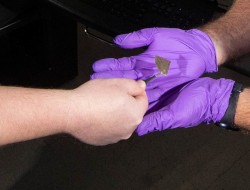Sandia scientists create tiny diode capable of protecting grid by diverting excess electricity in fractions of a second

Scientists at Sandia National Laboratories announced a major breakthrough in electricity protection last week, showcasing a small diode capable of shunting excess electricity within a few billionths of a second, marking a significant defensive tool against electromagnetic pulses.
According to fabrication and testing results published in the scientific journal IEEE Transactions on Electron Devices, the diode also proved remarkable for its operating voltage: 6,400 volts, a new record. Between both the speed and its operating voltage, it could protect against voltage surges up to and including EMPs – be they natural or man-made. EMPs cause massive voltage spikes in fractions of a second, wiping out electronic devices over broad areas.
“The reason why these devices are relevant to protecting the grid from an EMP is not just that they can get to high voltage — other devices can get to high voltage — but that they can respond in a couple billionths of a second,” Bob Kaplar, manager of a semiconductor device research group at Sandia, said. “While the device is protecting the grid from an EMP, it’s at a very high voltage, and thousands of amps are going through it, which is a huge amount of power. A material can only handle so much power for a certain amount of time, but we think the material in our diode has some advantages over other materials.”
Ideally, Sandia researchers seek to create a diode capable of operating at around 20,000 volts, as most grid distribution electronics operate at around 13,000 volts. In this way, it could act as a sort of regulator valve for the grid at large and, in particular, help protect the huge transformers that are its foundations. Losing one of those would require months of backlog to replace and leave whole portions of the nation without power for just as long.
On the other hand, Diodes are electronic components that exist in nearly every electronic device, offering one-way regulation. In other words: built-in means to convert AC power to DC power or divert damaging voltage away from sensitive equipment. Similar equipment exists to help the grid shrug off lightning strikes, but those work at one-millionth of a second. EMPs produce even faster voltage surges, operating at that billionth of a second level, so researchers are uncertain existing devices could help against something so quick and potent.
The material the Sandia device uses, gallium nitride, is the same basic material used for LEDs. It is a semiconductor not unlike silicon, with chemical properties that allow it to process much higher voltages before breaking down. The team admitted that significant work remains and technical challenges to be overcome before getting to a device that operates at 20,000 volts.
Even in its current form, the Sandia diode has numerous potential uses, according to Kaplar, including smart transformers for the grid, helping electronic devices convert electricity from roof-top solar panels to be usable by household appliances or electric car charging infrastructure.
“We have this primary goal of protection of the electrical grid, but these devices have other uses beyond that,” Jack Flicker, a Sandia electric grid resiliency expert on the development team, said. “It’s interesting to have our application area, but know that these devices can be used in power electronics, power converters, everything that’s at very high voltages.”
Funding for the project came from ARPA-E, as part of a larger project being collaborated on with the Naval Research Laboratory, Stanford University, National Institute of Standards and Technology, EDYNX, and Sonrisa Research.
